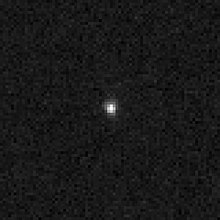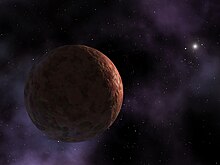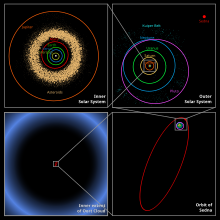90377 Sedna
90377 Sedna (or simply Sedna; symbol ![]() )[1] is a trans-Neptunian object which is the farthest dwarf planet from the Sun. It was discovered on November 14, 2003[2] by Mike Brown, Chad Trujillo and David Rabinowitz.[3][4] Around 1250-1800 km in diameter,[3] Sedna takes roughly 11,400 years to orbit the Sun, much higher than most known trans-Neptunian objects.[3][4] It is one of the most distant known objects in the Solar System. Therefore, Sedna's surface temperature never rises above -240°C.[2][3][4]
)[1] is a trans-Neptunian object which is the farthest dwarf planet from the Sun. It was discovered on November 14, 2003[2] by Mike Brown, Chad Trujillo and David Rabinowitz.[3][4] Around 1250-1800 km in diameter,[3] Sedna takes roughly 11,400 years to orbit the Sun, much higher than most known trans-Neptunian objects.[3][4] It is one of the most distant known objects in the Solar System. Therefore, Sedna's surface temperature never rises above -240°C.[2][3][4]



The name "Sedna" comes from the Inuit goddess of the sea, thought to live at the bottom of the Arctic Ocean.[3]
NASA is not currently planning any space missions to explore Sedna, but there is some talk of missions to happen when Sedna reaches perihelion again in 2076. It is considered to be a likely candidate as a dwarf planet.
No pictures can be taken of Sedna because very little light from the Sun reaches it. For this reason, Sedna is known as "Cobian", meaning shadows in Ancient Greek. Due to its orbit, the chances of Sedna being found were 0.017%. 40-120 more objects this size should exist without us knowing, but, as they are so small and far away, they may not be discovered for a while.
References
change- ↑ U+2BF2 ⯲. David Faulks (2016) 'Eris and Sedna Symbols,' L2/16-173R, Unicode Technical Committee Document Register.
- ↑ 2.0 2.1 Cox, Brian; Cohen, Andrew (2010). Wonders of the Solar System. HarperCollins. p. 26-27. ISBN 9780007386901.
- ↑ 3.0 3.1 3.2 3.3 3.4 Brown, Mike. "Sedna". Caltech. Retrieved 2011-07-11.
- ↑ 4.0 4.1 4.2 Clavin, Whitney (2004-03-15). "Planet-Like Body Discovered at Fringes of Our Solar System". NASA. Archived from the original on 2007-11-30. Retrieved 2011-07-11.